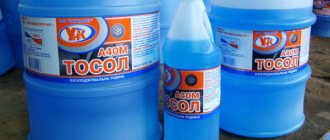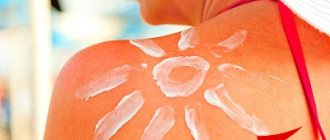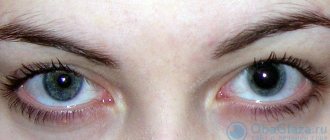Dosage form and main components
Atropine can be found in pharmacies in various forms.
- Powder – 0.5 mg.
- Tablets – 0.5 mg.
- Solution intended for oral administration – 10 ml.
- Solution released for injection in ampoules and syrettes - 1 ml each.
- Atropine sulfate drops, intended for the treatment of diseases of the organs of vision (1%), in the form of a solution, produced in 5 ml bottles.
- Eye ointment 1%.
- Films for the eyes. There are 30 of them in each bottle.
The main active ingredient of the drug is atropine sulfate. The secondary components are: hydrochloric acid, water for injection.
1 ml of eye drops contains 10 mg of the main substance, 1 ml of injection solution contains 1 mg.
Effect of the drug on the body
Atropine sulfate has an anticholinergic effect, that is, it disrupts the supply of nerve impulses by blocking m-cholinergic receptors. The effective mechanism is aimed at the binding of atropine sulfate not with acetylcholine, but with specific neuron formations. In this regard, the conduction of the nerve impulse is blocked. Atropine has the following effects depending on what disease the fight is aimed at:
- Promotes muscle relaxation, that is, Atropine solution is an antispasmodic. A similar effect is observed in the gastrointestinal tract, bronchi, urinary and biliary organs.
- Dilates the pupils.
- Reduces the activity of secretion of external glands. These include: bronchial, sweat, salivary, digestive glands.
- Increases heart rate.
- Paralyzes accommodation (the ability of the organ of vision to clearly perceive objects located at different distances).
- Improves conductivity of the atria and ventricles.
- It has an effect on blood vessels, that is, it promotes their expansion, but only if a significant dose is used.
The drug is also actively used in anesthesiology before or during surgery to reduce the secretion of the bronchial and salivary glands, weaken reflexes, and prevent laryngospasm.
Additional properties of the drug
In addition, the use of Atropine is advisable before X-ray examination of the intestines and stomach. The medicine is used for poisoning with organophosphorus compounds (sarin, chlorophos, karbofos). Atropine in this case acts as an antidote.
Pharmacological properties of Atropine
Atropine is found in some plants. Most of this substance is present in belladonna, henbane and dope. It is a fine-crystalline powder that is odorless and colorless. The substance dissolves quickly in water, alcohol, and is resistant to ether and chloroform.
If the solution is administered subcutaneously, the effect is achieved after 2–4 minutes; after using the drops, the effect of the product is observed after half an hour. In large doses, the medicine leads to stimulation of the nervous system.
MAIN PHARMACOLOGICAL EFFECTS OF ATROPINE
1. Atropine has especially pronounced antispasmodic properties. By blocking M-cholinergic receptors, atropine eliminates the stimulating effect of parasympathetic nerves on smooth muscle organs. The tone of the muscles of the gastrointestinal tract, bile ducts and gallbladder, bronchi, ureters, and bladder decreases.
2. Atropine also affects the tone of the eye muscles. Let's look at the effects of atropine on the eye:
a) when atropine is administered, especially when applied topically, due to a block of M-cholinergic receptors in the circular muscle of the iris, dilation of the pupil is noted - mydriasis. Mydriasis also intensifies as a result of the preservation of the sympathetic innervation of m. dilatator pupillae. Therefore, atropine acts on the eye for a long time in this regard - up to 7 days;
b) under the influence of atropine, the ciliary muscle loses its tone, it becomes flattened, which is accompanied by tension in the ligament of Zinn, which supports the lens. As a result, the lens also flattens, and the focal length of such a lens lengthens. The lens sets vision to the far point of vision, so nearby objects are not clearly perceived by the patient. Since the sphincter is in a state of paralysis, it is not able to constrict the pupil when viewing nearby objects, and photophobia (photophobia) occurs in bright light. This condition is called ACCOMMODATION PARALYSIS or CYCLOPLEGIA. Thus, atropine is both a mydriatic and a cycloplegic. Local application of a 1% atropine solution causes a maximum mydriatic effect within 30-40 minutes, and complete restoration of function occurs on average after 3-4 days (sometimes up to 7-10 days). Paralysis of accommodation occurs within 1-3 hours and lasts up to 8-12 days (approximately 7 days);
c) relaxation of the ciliary muscle and displacement of the lens into the anterior chamber of the eye is accompanied by a violation of the outflow of intraocular fluid from the anterior chamber. In this regard, atropine either does not change intraocular pressure in healthy individuals, or in individuals with a shallow anterior chamber and in patients with narrow-angle glaucoma, it may even increase, that is, lead to an exacerbation of an attack of glaucoma.
INDICATIONS FOR THE USE OF ATROPINE IN OPHTHALMOLOGY
1) In ophthalmology, atropine is used as a mydriatic to cause cycloplegia (paralysis of accommodation). Mydriasis is necessary when examining the fundus of the eye and in the treatment of patients with iritis, iridocyclitis and keratitis. In the latter case, atropine is used as an immobilization agent that promotes functional rest of the eye.
2) To determine the true refractive power of the lens when selecting glasses.
3) Atropine is the drug of choice if it is necessary to achieve maximum cycloplegia (paralysis of accommodation), for example, when correcting accommodative strabismus.
3. INFLUENCE OF ATROPINE ON ORGANS WITH SMOOTH MUSCLE. Atropine reduces the tone and motor activity (peristalsis) of all parts of the gastrointestinal tract. Atropine also reduces peristalsis of the ureters and the bottom of the bladder. In addition, atropine relaxes the smooth muscles of the bronchi and bronchioles. In relation to the biliary tract, the antispasmodic effect of atropine is weak. It should be emphasized that the antispasmodic effect of atropine is especially pronounced against the background of a previous spasm. Thus, atropine has an antispasmodic effect, that is, atropine acts in this case as an antispasmodic. And only in this sense can atropine act as a “painkiller”.
4. INFLUENCE OF ATROPINE ON THE ENDOCRECTION GLANDS. Atropine sharply weakens the secretion of all exocrine glands, with the exception of mammary glands. In this case, atropine blocks the secretion of liquid watery saliva caused by stimulation of the parasympathetic part of the autonomic nervous system, causing dry mouth. Tear production decreases. Atropine reduces the volume and overall acidity of gastric juice. In this case, suppression and weakening of the secretion of these glands can be up to their complete shutdown. Atropine reduces the secretory function of glands in the cavities of the nose, mouth, pharynx and bronchi. The secretion of the bronchial glands becomes viscous. Atropine, even in small doses, inhibits the secretion of SWEAT GLANDS.
5. INFLUENCE OF ATROPINE ON THE CARDIOVASCULAR SYSTEM. Atropine, taking the heart out of control n. vagus, causes TACHYCARDIA, that is, it increases the heart rate. In addition, atropine helps facilitate the conduction of impulses in the conduction system of the heart, in particular in the AV node and along the atrioventricular bundle as a whole. These effects are less pronounced in elderly people, since in therapeutic doses atropine does not have a significant effect on peripheral blood vessels; their tone is reduced. vagus Atropine does not have a significant effect on blood vessels in therapeutic doses.
6. INFLUENCE OF ATROPINE ON THE CNS. In therapeutic doses, atropine has no effect on the central nervous system. In toxic doses, atropine sharply excites the neurons of the cerebral cortex, causing motor and speech excitation, reaching mania, delirium and hallucinations. The so-called “atropine psychosis” occurs, leading further to a decrease in functions and the development of coma. It also has a stimulating effect on the respiratory center, but with increasing doses, respiratory depression may occur.
INDICATIONS FOR USE OF ATROPINE (except ophthalmological)
1) As an ambulance for:
a) intestinal
b) renal
c) hepatic colic.
2) For bronchospasms (see adrenergic agonists).
3) In complex therapy of patients with peptic ulcer of the stomach and duodenum (reduces the tone and secretion of the glands). It is used only in a complex of therapeutic measures, since it reduces secretion only in large doses.
4) As a means of presedation in anesthesiological practice, atropine is widely used before surgery. Atropine is used as a means of drug preparation of a patient for surgery because it has the ability to suppress the secretion of the salivary, nasopharyngeal and tracheobronchial glands.
As is known, many anesthetics (ether in particular) are strong irritants of the mucous membranes. In addition, by blocking M-cholinergic receptors of the heart (the so-called vagolytic effect), atropine prevents negative reflexes on the heart, including the possibility of its reflex stop.
By using atropine and reducing the secretion of these glands, the development of inflammatory postoperative complications in the lungs is prevented. This explains the importance of the fact that resuscitators attach when they talk about the full opportunity to “breathe” the patient.
5) Atropine is used in cardiology. Its M-anticholinergic effect on the heart is beneficial in some forms of cardiac arrhythmias (for example, atrioventricular block of vagal origin, that is, with bradycardia and heart block).
6) Atropine has found widespread use as an ambulance for poisoning:
a) AChE means (FOS)
b) M-cholinomimetics (muscarine).
Along with atropine, other atropine-like drugs are well known. Natural atropine-like alkaloids include SCOPOLAMINE (hyoscine) Scopolominum hydrobromidum. Available in ampoules of 1 ml - 0.05%, as well as in the form of eye drops (0.25%). Contained in the mandrake plant (Scopolia carniolica) and in the same plants that contain atropine (belladonna, henbane, datura). Structurally close to atropine. It has pronounced M-anticholinergic properties. There is one significant difference from atropine: in therapeutic doses, scopolamine causes mild sedation, central nervous system depression, sweating and sleep. It has a depressing effect on the extrapyramidal system and the transmission of excitation from the pyramidal tracts to the motor neurons of the brain. Introducing the drug into the conjunctival cavity causes less prolonged mydriasis.
Therefore, anesthesiologists use scopolomine (0.3-0.6 mg s.c.) as a premedication, but usually in combination with morphine (but not in the elderly, as it can cause confusion). It is sometimes used in psychiatric practice as a sedative, and in neurology for the correction of parkinsonism. Scopolamine has a shorter duration of action than atropine. They are also used as an antiemetic and sedative for sea and airborne illnesses (Aeron tablets are a combination of scopolamine and hyoscyamine).
PLATIFYLLINE also belongs to the group of alkaloids obtained from plant raw materials (rhombolic ragwort) (Platyphyllini hydrotartras: tablets of 0.005, as well as ampoules of 1 ml - 0.2%; eye drops - 1-2% solution). It acts in much the same way, causing similar pharmacological effects, but weaker than atropine. It has a moderate ganglion-blocking effect, as well as a direct myotropic antispasmodic effect (papaverine-like), as well as on the vasomotor centers. Has a calming effect on the central nervous system. Platiphylline is used as an antispasmodic for spasms of the gastrointestinal tract, bile ducts, gallbladder, ureters, with increased tone of the cerebral and coronary vessels, as well as for the relief of bronchial asthma. In ophthalmic practice, the drug is used to dilate the pupil (it has a shorter effect than atropine and does not affect accommodation). It is administered under the skin, but it should be remembered that solutions of 0.2% concentration (pH = 3.6) are painful.
For ophthalmic practice, HOMATROPINE (Homatropinum: 5 ml bottles - 0.25%) is proposed. It causes pupil dilation and paralysis of accommodation, that is, it acts as a mydriatic and cycloplegic. The ophthalmic effects caused by homatropine last only 15-24 hours, which is much more convenient for the patient compared to the situation when atropine is used. The risk of raising IOP is less, since atropine is weaker, but at the same time, the drug is contraindicated for glaucoma. Otherwise, it is not fundamentally different from atropine; it is used only in ophthalmic practice.
The synthetic drug METACIN is a very active M-anticholinergic blocker (Methacinum: in tablets - 0.002; in ampoules 0.1% - 1 ml. A quaternary ammonium compound that poorly penetrates the BBB. This means that all its effects are due to peripheral M -cholinergic blocking effect.
It differs from atropine in having a more pronounced bronchodilator effect and no effect on the central nervous system. It suppresses the secretion of the salivary and bronchial glands more strongly than atropine. Used for bronchial asthma, peptic ulcer, for relieving renal and hepatic colic, for premedication in anesthesiology (iv - in 5-10 minutes, intramuscularly - in 30 minutes) - more convenient than atropine. The analgesic effect is superior to atropine and causes less tachycardia.
Among medicines containing atropine, belladonna (belladonna) preparations are also used, for example, belladonna extracts (thick and dry), belladonna tinctures, and combined tablets. These are weak drugs and are not used in ambulances. Used at home at the pre-hospital stage.
Finally, a few words about the first representative of selective muscarinic receptor antagonists. It turned out that in different organs of the body there are different subclasses of muscarinic receptors (M-one and M-two). Recently, the drug gastrocepin (pirenzepine) was synthesized, which is a specific inhibitor of M-one cholinergic receptors of the stomach. Clinically, this is manifested by intense inhibition of gastric juice secretion. Due to the pronounced inhibition of gastric juice secretion, gastrocepin causes persistent and rapid pain relief. Used for stomach and duodenal ulcers, gastritis, daudenitis. It has significantly fewer side effects and has virtually no effect on the heart and does not penetrate into the central nervous system.
SIDE EFFECTS OF ATROPINE AND ITS DRUGS.
In most cases, side effects are a consequence of the breadth of the pharmacological action of the drugs being studied and are manifested by dry mouth, difficulty swallowing, intestinal atony (constipation), blurred visual perception, and tachycardia. Topical use of atropine can cause allergic reactions (dermatitis, conjunctivitis, swelling of the eyelids). Atropine is contraindicated in glaucoma.
ACUTE POISONING WITH ATROPINE, ATROPINE-LIKE DRUGS AND PLANTS CONTAINING ATROPINE.
Atropine is far from a harmless drug. Suffice it to say that even 5-10 drops can be toxic. The lethal dose for adults when taken orally starts from 100 mg, for children - from 2 mg; When administered parenterally, the drug is even more toxic. The clinical picture of poisoning with atropine and atropine-like drugs is very characteristic. There are symptoms associated with the suppression of cholinergic influences and the effect of the poison on the central nervous system. At the same time, depending on the dose of the ingested medication, MILD and SEVERE courses are distinguished.
In case of mild poisoning, the following clinical signs develop:
1) dilated pupils (mydriasis), photophobia;
2) dry skin and mucous membranes. However, due to a decrease in sweating, the skin becomes hot and red, there is an increase in body temperature, and a sharp flushing of the face (the face is “bursting with heat”);
3) dryness of mucous membranes;
4) severe tachycardia;
5) intestinal atony.
In case of severe poisoning, against the background of all these symptoms, PSYCHOMOTOR Arousal comes to the fore, that is, both mental and motor arousal. Hence the well-known expression: “I’ve eaten too much henbane.” Motor coordination is impaired, speech is blurred, consciousness is confused, and hallucinations are noted. Phenomena of atropine psychosis are developing, requiring the intervention of a psychiatrist. Subsequently, depression of the vasomotor center may occur with a sharp expansion of the capillaries. Collapse, coma and respiratory paralysis develop.
HELP MEASURES FOR ATROPINE POISONING
If the poison is taken orally, then an attempt should be made to pour it out as quickly as possible (gastric lavage, laxatives, etc.); astringents - tannin, adsorbents - activated carbon, forced diuresis, hemosorption. It is important to apply specific treatment here.
1) Before washing, a small dose (0.3-0.4 ml) of sibazon (Relanium) should be administered to combat psychosis and psychomotor agitation. The dose of sibazon should not be large, as the patient may develop paralysis of vital centers.
In this situation, aminazine cannot be administered, since it has its own muscarinic-like effect.
2) It is necessary to displace atropine from its connection with cholinergic receptors; various cholinomimetics are used for these purposes. It is best to use physostigmine (iv, slowly, 1-4 mg), which is what they do abroad. We use AChE agents, most often prozerin (2-5 mg, s.c.). Medicines are administered at intervals of 1-2 hours until signs of elimination of the blockade of muscarinic receptors appear. The use of physostigmine is preferable because it penetrates well through the BBB into the central nervous system, reducing the central mechanisms of atropine psychosis. To alleviate photophobia, the patient is placed in a darkened room and rubbed with cool water. Careful care is required. Artificial respiration is often required.
N-CHOLINERGIC DRUGS
Let me remind you that H-cholinergic receptors are localized in the autonomic ganglia and end plates of skeletal muscles. In addition, H-cholinergic receptors are located in the carotid glomeruli (they are necessary to respond to changes in blood chemistry), as well as the adrenal medulla and the brain.
The sensitivity of H-cholinergic receptors of different localization to chemical compounds is not the same, which makes it possible to obtain substances with a predominant effect on the autonomic ganglia, cholinergic receptors of neuromuscular synapses, and the central nervous system.
Drugs that stimulate H-cholinergic receptors are called H-cholinomimetics (nicotinomimetics), and those that block them are called H-cholinergic blockers (nicotine blockers).
It is important to emphasize the following feature: all H-cholinomimetics excite H-cholinergic receptors only in the first phase of their action, and in the second phase the excitation is replaced by an inhibitory effect. In other words, N-cholinomimetics, in particular the reference substance nicotine, have a two-phase effect on H-cholinergic receptors: in the first phase, nicotine acts as an N-cholinomimetic, in the second - as an N-cholinergic blocker.
Indications for use
Atropine solution is used widely in clinical practice. Here are the main indications for the use of the drug.
- Ulcerative lesions of the stomach and duodenum. The main purpose of the drug is to suppress the secretory function of organs.
- Contraction of the pylorus of the stomach in order to relax it.
- Cholelithiasis (cholelithiasis), an inflammatory process in the organ. The main purpose of the drug is to widen the ducts for the passage of stagnant bile.
- Pancreatitis in the acute stage.
- Intestinal, hepatic, biliary colic.
- Bronchial asthma - to eliminate bronchospasm.
- Inhibition of bronchial secretion, as well as salivary, sweat, and lacrimal secretions.
- Bronchitis with hypersecretion, bronchospasm.
- Excessive sweating.
- Hypersalivation - excessive salivation.
- Bradycardia is symptomatic.
- Poisoning of the body with organophosphorus compounds.
- The need to dilate the pupil to examine the fundus.
- Ensuring functional rest of the organ of vision during an inflammatory process or injury.
Rules of use and optimal dosages for various diseases
The drug with atropine can be taken orally, injected subcutaneously, into a vein, into muscles. In each individual case, a certain dosage and course of treatment are established.
So, for ulcerative lesions of the stomach and duodenum, you should take 0.25–1 mg. This is a daily dosage for adults, which is divided into 3 doses. As for children, the dose of the medicine should be reduced to 0.05–0.5 mg per day and divided into 1–2 doses.
Features of the use of Atropine
The maximum daily dosage of Atropine should not be more than three mg. If intravenous, subcutaneous, or intramuscular administration is required, then the highest dosage in this case is 0.25–1 mg and is divided into 1–2 administrations.
Atropine sulfate drops for the treatment of eye diseases are injected into the organs of vision, 1-2 drops. The frequency of use of the medicine is 3 times a day. Eye ointment is applied to the eyelids 1 (if necessary 2 times) per day.
Atropine as an antidote
Atropine is a classic blocker of central M-cholinergic receptors and peripheral M-cholinergic receptors.
Used as an antidote for the treatment of poisoning by M-anticholinergic stimulants and AChE inhibitors, for example, organophosphorus insecticides and chemical warfare agents. Chemical properties
Atropine, along with scopolamine, is classified as tropane alkaloids, which are tertiary amines and therefore easily penetrate the central nervous system. M-anticholinergics related to quaternary amines, for example glycopyrronium bromide, ipratropium bromide, tiotropium bromide, are not able to cross the blood-brain barrier.
Pharmacodynamics
Cholinergic receptors are divided into M- and N-cholinergic receptors. Atropine is an M-cholinergic receptor blocker. These receptors are widely represented in the central and peripheral nervous systems. The duration of action of atropine depends on the dose, route of administration and averages 24 hours or more, if we take into account the effect on individual organs.
AChE inhibitors (in particular, organophosphate and carbamate insecticides, nerve agents) prevent the breakdown of acetylcholine and, as a result, lead to its accumulation and constant stimulation of cholinergic receptors. The effect of atropine in such cases is due to the cessation of stimulation of M-cholinergic receptors.
Pharmacokinetics
Atropine is rapidly absorbed through various routes of administration - inhalation, oral administration and intramuscular injection. When 1 mg of atropine is taken orally, the maximum effect on heart rate and salivation is observed after 1 and 3 hours, respectively. 1 hour after administration of 1 mg of atropine to an adult, its serum concentration is the same for both intramuscular and intravenous injections. When administered intramuscularly using an auto-injector, the time to achieve the maximum effect is significantly shorter compared to administration with a conventional syringe. After intramuscular administration of atropine to adults at a dose of 0.02 mg/kg, T1/2 absorption and elimination were 8 minutes and 2.5 hours, respectively. From 34 to 57% of the drug is excreted by the kidneys.
When atropine is instilled into the eyes, mydriasis is observed, caused by blockade of M3-cholinergic receptors of the sphincter of the pupil. The effect reaches its maximum within 30-40 minutes and lasts 7-10 days. Atropine also causes paralysis of accommodation (the effect reaches a maximum after 1-3 hours, lasts 6-12 days), blocking M3 cholinergic receptors of the ciliary muscle.
A study of the bioavailability of atropine from eye drops when taken orally showed that in healthy people it is absorbed by an average of 65%. although this figure varied significantly. The maximum serum concentration was reached after 30 minutes, T/2 was 2.5 hours. Thus, in the case of mass poisoning, atropine in the form of eye drops can be successfully used as an antidote to replace the drug for parenteral administration in case of deficiency of the latter.
When atropine is inhaled, maximum serum concentration is achieved after 1.3 hours.
Contraindications
It is prohibited to use the drug in any form for the following pathologies:
- closed-angle and open-angle glaucoma;
- synechiae of the iris;
- if there is a narrow angle between the cornea and the iris;
- keratoconus (thinning of the cornea);
- intolerance to atropine sulfate;
- prostatic hypertrophy;
- kidney disease;
- cachexia.
There are also a number of restrictions that prohibit the use of the drug. This:
- vascular and heart diseases;
- high body temperature;
- diseases and hernias of internal organs;
- reflux esophagitis;
- increased intraocular pressure;
- ulcerative colitis is nonspecific.
The drug is also contraindicated in children under 7 years of age.
Side effects of the drug
The use of Atropine for various diseases can cause undesirable effects. These include:
- headache;
- sleep disturbance, insomnia;
- dizziness;
- euphoria, hallucination;
- confusion;
- strong pupil dilation;
- paralysis of accommodation;
- violation of tactile perception;
- photophobia;
- if you use drops of atropine sulfate, then in rare cases, hyperemia of the eyeball, swelling of the conjunctiva, irritation and swelling of the eyelids may be observed;
- tachycardia;
- dry mouth;
- constipation;
- difficulty urinating;
- increased intraocular pressure;
- fever;
- worsening myocardial ischemia.
pharmachologic effect
Atropine is an anticholinergic and antispasmodic agent . The active substance of this drug is Atropine, which is a poisonous alkaloid found in the leaves and seeds of plants of the nightshade family, such as henbane, belladonna, and dope. The main chemical feature of Atropine is its ability to block the body's M-cholinoreactive systems, which are located in the heart muscle, organs with smooth muscles, the central nervous system and secretory glands. As a result of this blocking, M-cholinergic receptors become insensitive to the mediator of nerve impulses (acetylcholine).
The use of Atropine helps to reduce the secretory function of the glands, relax the tone of the smooth muscle organs, dilate the pupil, increase intraocular pressure and paralysis of accommodation (the ability of the eye to change the focal length). The acceleration and stimulation of cardiac activity after the use of Atropine is explained by its ability to relieve the inhibitory influences of the vagus nerve. The effect of Atropine on the central nervous system occurs in the form of stimulation of the respiratory center, and when using toxic doses, motor and mental agitation (convulsions, visual hallucinations) is possible.
Atropine quickly penetrates the bloodstream from the site of application, and then is distributed in the body in a short period of time . The maximum effect of the drug after intravenous administration occurs after 2-4 minutes, after oral administration - after half an hour. Plasma protein binding occurs by 18%. The drug is able to pass through the placental and blood-brain barriers. Excreted by the kidneys, excreted in the urine both in the form of metabolites and unchanged. Traces of the drug can be found in breast milk.
Overdose when using Atropine
If you exceed the dose of the medicine, the person will experience the following symptoms:
- nausea, urge to vomit;
- dryness and burning in the mouth;
- difficulty swallowing;
- photophobia;
- dryness and redness of the skin;
- increase in body temperature, up to maximum levels;
- tachycardia;
- increased blood pressure.
An overdose of Atropine primarily affects the state of the nervous system. In this case, the person will feel: confusion, tremors of the limbs, anxiety, unreasonable fear, hallucinations and delirium, drowsiness and stupor. If measures are not taken in time, this can result in death caused by vascular, cardiac or respiratory failure.
Atropine poisoning
Atropine can be used as follows:
- Intramuscular injections.
- Intravenous injections.
- Subcutaneous drops.
- Eye drops.
- Ingestion.
Since atropine contains poison, an excessive dose of atropine can cause irreversible consequences. The most common is food poisoning, but if first aid is not provided, a person may die. The drug is especially dangerous for children.
Poisoning is divided into two categories: intentional, and also accidental when the stable dosage is exceeded. Depending on the type of poisoning, a person will experience different symptoms.
In case of an accidental minor overdose, a person may be susceptible to:
- dry mouth;
- decreased sweat production;
- redness on the mucous membrane of the eyes;
- arrhythmias;
- constipation;
- increased breathing;
- convulsions;
- tremor;
- difficulty swallowing food.
If the overdose was not intentional, symptoms such as:
- loss of consciousness;
- hallucinations;
- falling into a coma;
- decreased heart rate;
- paralysis of the respiratory muscles.
Although an overdose of atropine can lead to quite dangerous consequences, there is an antidote that can eliminate the poisoning.











